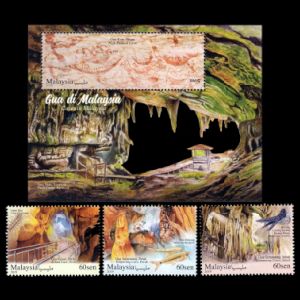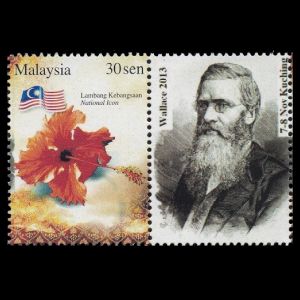the place where Paleontology and Paleoanthropology meets Philately
Malaysia
Fossil sites on stamps of Malaysia
| << previous country | back to index | next country >> |
Contents:
- Country overview
- Philately of Malaysia
- Some stamps of Malaysia to consider
- Some personalized stamps of Malaysia to consider
- References
- Acknowledgements
Malaysia, is a country in Southeast Asia. The federal constitutional monarchy consists of thirteen states and three federal territories, separated by the South China Sea into two regions, Peninsular Malaysia and Borneo's East Malaysia.
Peninsular Malaysia shares a land and maritime border with Thailand and maritime borders with Singapore, Vietnam, and Indonesia.
East Malaysia shares land and maritime borders with Brunei and Indonesia and a maritime border with the Philippines and Vietnam.
Kuala Lumpur is the national capital, largest city and the seat of the legislative branch of the federal government.
Malaysia has a population of over 32 million.
Malaysia has its origins in the Malay kingdoms which, from the 18th century, became subject to the British Empire, along with the British Straits Settlements protectorate. Peninsular Malaysia was unified as the Malayan Union in 1946. Malaya was restructured as the Federation of Malaya in 1948 and achieved independence on 31 August 1957. The independent Malaya united with the then British crown colonies of North Borneo, Sarawak, and Singapore on 16 September 1963 to become Malaysia. In August 1965, Singapore was expelled from the federation and became a separate independent country. [R1]
Malaysia has been issuing stamps after independence from the United Kingdom in 1957, first as the Federation of Malaya, then as Malaysia after 1963. [R2]
So far, there are no stamps of the country that directly relate to paleontology or paleoanthropology.
The only postal items of Malaysia depicting prehistoric animals are postcards. For example, some postcards with dinosaur sculptures from the entertainment park – “S2 Height Hill Park”.

Hill Park is located at one of the highest points in S2 Heights, at 162 meter above sea level, and spans over 30 acres of space.
The park is designed as a walking park – with parking at the base of the hill and a pathway up to the exhibits. The park has a variety of dinosaur replicas on display along the path. [R3]
Some stamps of Malaysia to consider: fossil site
| 22.08.2019 "Caves of Malaysia" [A1] | ||
 |
|
|
Notes:
[A1] Niah Caves, shown on the block, is the limestone cave and archeological site.
The cave is an important prehistoric site where human remains from 40,000 years ago have been found.
This is the oldest recorded human settlement in east Malaysia. More recent studies published in 2006 have shown evidence of the first human activity at the Niah caves from ca. 46,000 to ca. 34,000 years ago.
Painted Cave, situated in a much smaller limestone block of its own, some 150 metres from the Great Cave block's south eastern tip, has rock paintings dated at 1,200 years old.
Archeologists have claimed a much earlier date for stone tools found in the Mansuli valley, near Lahad Datu in Sabah, but precise dating analysis has not yet been published. [R4]
Some personalized stamps of Malaysia to consider: contributors to Paleontolgy
| xx.xx.2013 "100 years since death of Alfred Russel Wallace" [P1] | ||
 |
|
|
Notes:
[P1] Alfred Russel Wallace (1823-1913) was a British naturalist, explorer, geographer, anthropologist and biologist. He is best known for independently proposing a theory of evolution due to natural selection that prompted Charles Darwin to publish his own theory. Wallace was a prolific author who wrote on both scientific and social issues; his account of his adventures and observations during his explorations in Indonesia and Malaysia. The Malay Archipelago, was one of the most popular and influential journals of scientific exploration published during the 19th century. For more details about Wallace contribution to Evolutionary Biology please go here.
References:
- [R1] Malaysia:
Wikipedia,
FlagCounter.
- [R2] Postal History and Philately of Malaysia:
Wikipedia,
Links to official website of the Post Authority, stamp catalog and a list of new stamps of Malaysia are here - [R3] S2 Height Hill Park: Reverse side of the Postcards.
- [R4] The Niah National Park: Wikipedia.
Acknowledgements:
Many thanks to Dr. Peter Voice from Department of Geological and Environmental Sciences, Western Michigan University, for the draft page review and his very valuable comments.
| << previous country | back to index | next country >> |